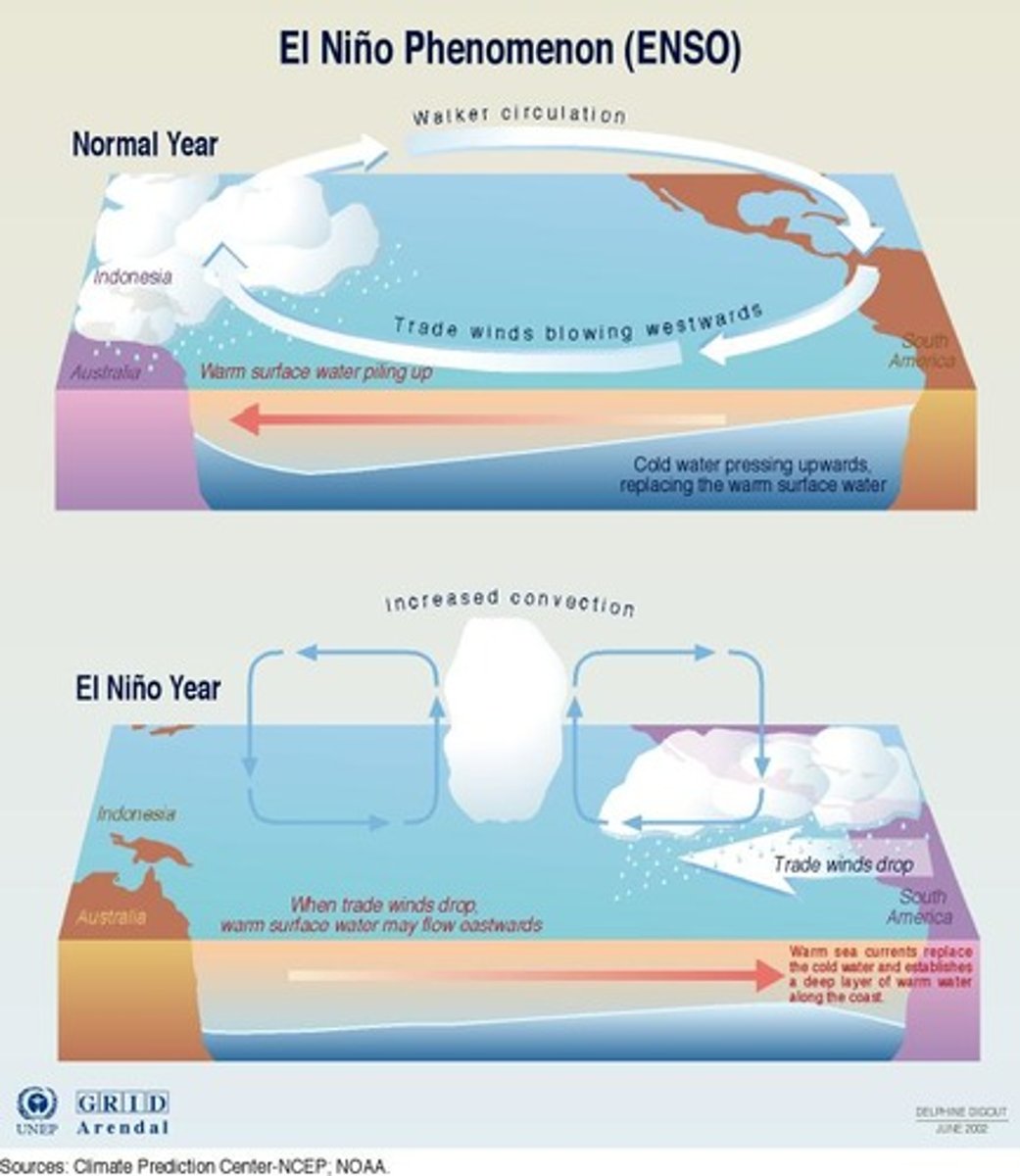Unit 4: (4.7 || 4.9) Seasons & El Nino/La Nina
1/15
There's no tags or description
Looks like no tags are added yet.
Name | Mastery | Learn | Test | Matching | Spaced |
|---|
No study sessions yet.
16 Terms
unequal heating of Earth's surface
1) The sun's rays strike the earth more directly at the equator. The rays are spread out over more surface area at higher latitudes.
2) The sun's rays pass through more atmosphere at higher latitudes due to the curvature of the earth.
insolation
incoming solar radiation (sunlight) to earth; depends on the latitude and season
Seasons
Caused by the tilt of Earth on its axis as it revolves around the Sun. Winter in a hemisphere happens when it tilts away from the sun, and summer when it tilts towards the sun.
Latitude
Distance north or south of the equator; higher latitudes = further away from the equator (0) and closer to the poles (90)
Solar intensity
The amount of solar energy striking a given location on earth. Higher intensity = more incoming energy from the sun
Equator
An imaginary circle at 0 degrees latitude, halfway between the North Pole and the South Pole; where the suns rays strike earth most directly
Earth's axis of rotation
tilted 23.5 degrees with respect to the sun. This causes earth's seasons, as the northern hemisphere tilts towards the sun (summer) and away from the sun (winter), while it orbits.
Solstice
The two days of the year when one hemisphere is maximally tilted towards the sun and the other is maximally tilted away. Summer solstice = longest day of the year, winter solstice = shortest day of the year.
Equinox
The two days of the year on which neither hemisphere is tilted toward or away from the sun. Both hemisphere's experience almost exactly 12 hours of day and 12 hours of night (equal <-> equinox)
infrared radiation
Electromagnetic waves given off from earth's surface as heat when sunlight strikes it. Trapped by greenhouse gases in the atmosphere, heating earth.
Microclimate
Climate within a small area that differs significantly from the climate of the surrounding area
El Nino-Southern Oscillation (ENSO)
Periodic changes in winds and ocean current in the Pacific. southern trade winds along the equator weaken or even reverse direction, blowing warm water east (towards the Americas) instead of west (away from them). Suppresses upwelling on the west coast of South America & brings warm, rainy weather to the west coast of the Americas.

La Nina Effect
A strengthening of the southern trade winds along the equator in the Pacific, leading to increased upwelling of cold ocean water. produces a cold current with unusually cold surface waters in the Pacific.
Upwelling
The movement of deep, cold, and nutrient-rich water to the surface of the ocean. Particularly along the coast of South America where trade winds typically blow warm surface waters west (away from the coast). Leads to quality fishing with increased nutrients in the water.
thermohaline circulation
Oceanic circulation pattern that drives the mixing of surface water and deep water. Water at the equator is warmed by the sun and spreads out towards the poles. At the poles it gets colder and more dense. It sinks, spreads across the ocean floor, and eventually rises at the equator again, completing the cycle.
Gyres
Huge circular water systems that determinate the currents of the ocean's waters. Clockwise in the N hemisphere and Counterclockwise in the S hemisphere.